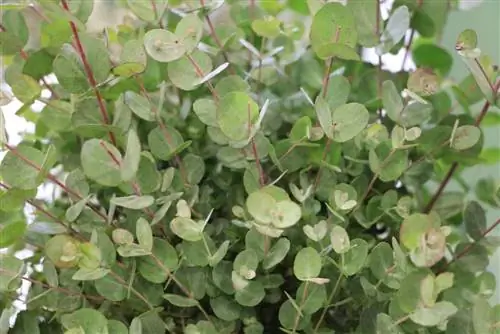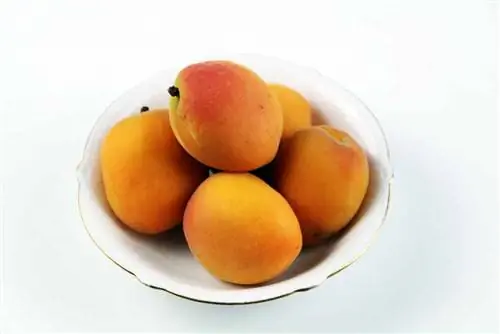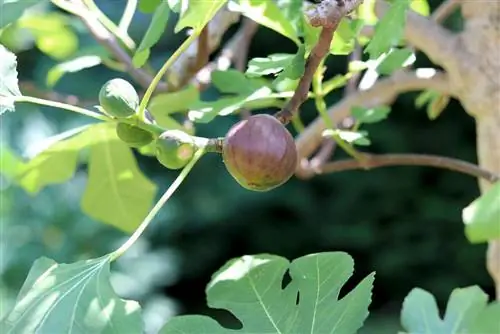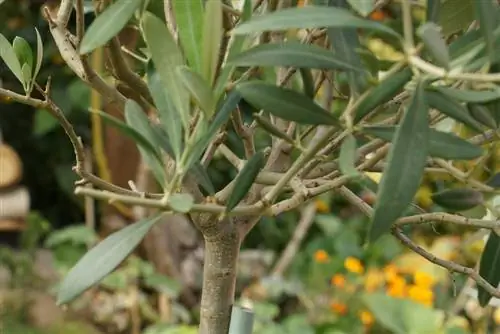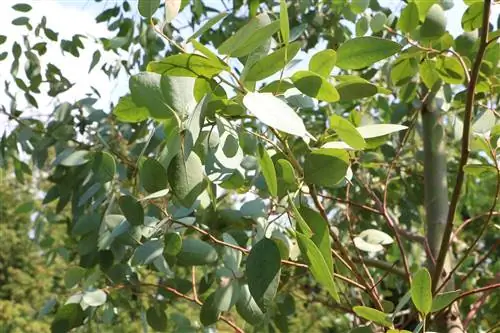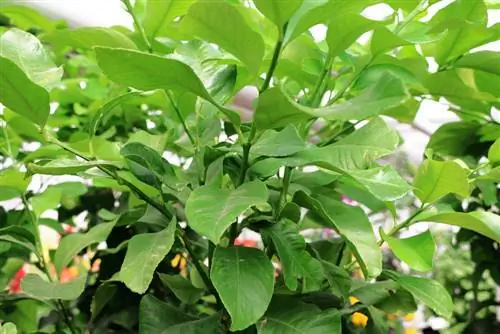- Author admin [email protected].
- Public 2023-12-17 03:39.
- Last modified 2025-01-24 12:45.
The eucalyptus is one of the interesting ornamental plants because its leaves exude an intense aroma and can even be used in some species. The care is a little more complex because the tropical plant is not adapted to the climatic conditions in Germany. In addition to attention in summer, the plant also needs some attention in winter for he althy growth.
Ensure development time
The ideal planting time is in spring because the sensitive trees need time to take root. To ensure that they survive the winter outdoors, you should not plant the plants too late. Frost-hardy species can be planted outdoors in mid-May after the Ice Saints. Choose a spot in full sun to give the sun-hungry plant optimal location conditions. In Germany, frost-sensitive species are only suitable for cultivation in pots. You like to spend the warm season outside:
- Put pots outside after the Ice Saints
- prefer a wind-protected location on a southern wall of the house
- Buckets can stay on the balcony and terrace until autumn
Tip:
You can sink frost-sensitive eucalyptus species in the ground using a pot. To do this, use clay pots without glazing, which automatically regulate the water balance.
Provide fertile soil
Almost all eucalyptus species prefer nutrient-rich soil that ensures high water drainage. The trees feel comfortable in slightly acidic to neutral soil. Normal garden soil is amended with compost before planting to increase fertility. If the soil has a lot of clay, it can be improved with a mixture of sand and compost.
Optimize water permeability
Eucalyptus species are very sensitive to waterlogging in the substrate. Their roots quickly begin to rot if irrigation or rain water cannot drain away optimally. Many substrates tend to compact. In the open field, the irrigation water flows off the surface and does not penetrate to the root ball. With potted plants, the bottom of the pot can easily become waterlogged if a permeable substrate is not used. Mix coarse-grained ingredients into the substrate to create small voids in the soil. Potted plant soil is enriched with coarse sand so that the irrigation water can drain off better.
Tip:
An elevated location in the garden such as a raised bed or a terrace slope optimizes water drainage.
Compensate water loss
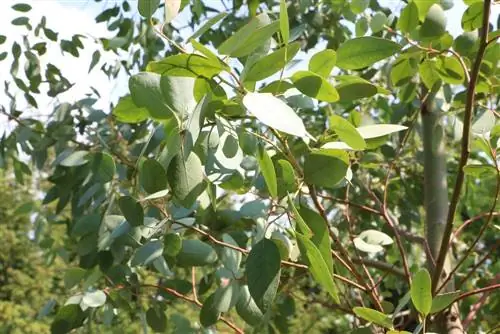
The eucalyptus tree has comparatively large leaves through which large amounts of water evaporate when exposed to direct sunlight. In order for the tropical tree to survive in Germany, it should be watered regularly. Make sure the soil is evenly moist, as the ornamental plant does not like extreme fluctuations. A balanced water balance leads to rapid growth and optimal leaf coloring. The water requirement is reduced outside the main growing season. While you rarely have to water the plant in winter, the eucalyptus tree needs more attention in summer:
- Allow the substrate surface to dry before each watering
- Check moisture in the substrate with your finger
- water thoroughly and pour off excess water
Tip:
Pot substrates in particular tend to dry out on the surface. However, there is usually enough moisture under the crumbly crust, which is why a finger test should definitely be used.
Avoid limescale intake
Tropical plants cannot tolerate lime, which is why you should not only prepare the soil accordingly. When watering, you also have to make sure that the plant does not get too much lime. If the tap water in your region is very hard, let it stand for a while. As a result, the lime settles on the vessel wall and only a few residues remain in the irrigation water. You can also boil the water or mix it with distilled water. The best option is to water with rainwater.
Met nutrient needs
A high nutrient supply supports the eucalyptus and ensures rapid leaf development. The growth period begins again in spring after the tree has survived the winter dormancy. From this point on, you can give the tree nutrients every two to four weeks. Use a complete fertilizer during this phase and follow these tips:
- Administer fertilizer in normal concentration
- too high nutrient supply leads to excessive growth
- Fertilizer should contain little nitrogen and phosphorus.
In the summer, switch to a potassium fertilizer, as this supports the strengthening of the leaf and cell tissue. This allows the eucalyptus to prepare optimally for the upcoming winter. From August onwards, the nutrient supply is slowly reduced so that the eucalyptus can enter the dormant phase.
Promote budding
Pruning measures are carried out in early spring because this promotes leaf shoots and the eucalyptus develops dense foliage. The blue gum tree (Eucalyptus globulus) develops silver-gray leaves that look particularly aesthetic on the young shoots. Such species can be cut back more heavily in spring so that the fresh foliage can be optimally displayed. The average growth per year for a eucalyptus is 40 centimeters. Trees with lush growth can also be trimmed in autumn. How to cut the tree correctly:
- remove crooked branches or annoying branches
- Pruning possible down to stronger leading branches
- Sprouts are cut back to two to three buds
- apply lacquer balm to larger wounds
Repot in time
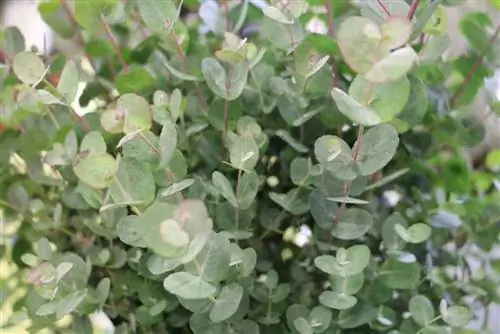
Eucalyptus trees quickly grow over your head, so they have to be repotted up to twice a year in optimal living conditions. This means that eucalyptus species are only suitable for cultivation in pots for a few years. The trees can easily be repotted in the fall, as long as they are given a period of recovery before being placed in their winter quarters. The root ball should not be trimmed as this measure takes too much energy. There will be a watering break of two days before returning to the normal watering rhythm.
Outdoor winter protection
Many eucalyptus species are sold in stores as frost-hardy, but can only tolerate low temperatures below zero. In Germany, only those species that do not feel comfortable in pots because of their growth size are planted outdoors. While the trees survive in mild winter regions without winter protection, they should be well protected from frost outside of these zones. Eucalyptus trees are not adapted to winter temperatures. They easily develop cracks on the trunk in winter sun combined with frost. If the ground freezes, there is a risk of drying out. If you cannot overwinter the eucalyptus indoors, you should protect the tree accordingly:
- Cover the substrate with a thick layer of mulch
- Wrap burlap or reed mats around the trunk
- Wrap branches with transparent garden fleece
Avoid winter damage
So that you can enjoy your eucalyptus tree for a long time, you should overwinter the plant in a frost-free area. Place the pot in a light-flooded room where temperatures are between five and ten degrees Celsius. Eucalyptus is evergreen and retains its foliage even in winter, so the tree needs light even during the cold season. Before the winter break begins, you should cut back the tips slightly.
Note:
If you overwinter the tree in warmer weather, you will have to adjust the care and water more frequently.
Adjust humidity
Because of its strong-smelling essential oils, the eucalyptus tree is extremely resistant to diseases and pests. If the tree is in a heated room in winter, aphids find optimal living conditions in the dry microclimate. They mainly colonize the freshly emerging leaves and suck the plant sap from the tissue. The pests leave behind sticky secretions called honeydew, which are an ideal breeding ground for sooty mold fungi. To prevent pest infestation, you should place a bowl of water on the heater. This increases the humidity in the room, which aphids don't like. If the sucking insects have spread, you can easily fight them in the early stages:
- Water the plant with a hard jet of water
- Spray a solution of rapeseed oil and water on the aphids
- Wipe the underside of the leaves with a cloth

